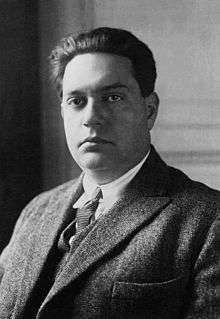La création du monde
| La Création du monde (The Creation of the World) | |
|---|---|
|
Darius Milhaud in 1923. | |
| Choreographer | Jean Börlin |
| Music | Darius Milhaud |
| Based on | African folk mythology |
| Premiere |
25 October 1923 Théâtre des Champs-Élysées, Paris |
| Original ballet company | Ballets suédois |
La Création du monde, Op. 81a, is a 20-minute-long ballet composed by Darius Milhaud in 1922–23 to a libretto by Blaise Cendrars, which outlines the Creation of the World based on African folk mythology. The premiere took place on 25 October 1923 at Théâtre des Champs-Élysées in Paris.
Background
On a trip to the United States in 1922, Darius Milhaud heard "authentic" jazz on the streets of Harlem,[1] which left a great impact on his musical outlook. Using jazz elements, the following year he finished composing La Création du monde, which was cast as a ballet in six continuous parts.[1] The work was commissioned by the Ballets suédois, a ballet company which was contemporary to Diaghilev's Ballets Russes.[2] The company was very influential in the early 1920s, staging five seasons in Paris and touring continually.
The ballet reflects both the ideal of the aesthetic of Les six to combine popular forms of art, and a centuries-old French penchant for exotica. Milhaud was very susceptible to all kinds of influences, but it was a different type of exotica that drew him. He was in the Paris of Le jazz hot, singer Josephine Baker, Pablo Picasso's paintings, and the sculptures inspired by African masks.[2] During the Early 20s, African (and Afro-American) fashion was sweeping Paris, and this ballet may have been Ballets suédois' attempt to follow the trend.[2]
When Milhaud first heard an American jazz band in London (1920), he was reportedly so captivated that he took off to New York City to spend time in clubs and bars, visit Harlem and mingle with jazz musicians.[2] After returning to France, Milhaud began to write in what he called a jazz idiom. He chose to color his music with bluesy turns of harmony and melody, swinging climaxes, and stomping rhythms.[2] Jazz influences appear in many of his compositions, but this ballet was the first opportunity to express his new passion; even the instrumental grouping also draws on his memories of New York City: "In some of the shows," Milhaud noted, "the singers were accompanied by flute, clarinet, trumpets, trombone, a complicated percussion section played by just one man, piano and string quartet." [2]
Reception
At the time, La Création du monde was more a succès de scandale than a true success.[2] The ballet costumes designed by Fernand Léger (who also created the stage sets) worked well visually, but were difficult to dance in; the costumes were heavy and inflexible to move freely.[2]
The costumes and sets from the original performance of La Création du monde still survive in museums and galleries, while the music has taken its place in the concert repertoire. The choreography is revived occasionally out of curiosity.[2]
Instrumentation
The score is written for a small orchestra of seventeen instruments: 7 woodwinds (2 flutes, oboe, 2 clarinets, bassoon, alto saxophone), 4 brass (horn, 2 trumpets, trombone), piano, percussion, and strings (2 violins, violoncello, double bass). The alto saxophone part appears in the score where a viola part would generally be. Milhaud also made a version for piano and string quartet (Op. 81b).[2][3]
Structure
The ballet is in six parts, played continuously in one movement as follows:[1]
Ouverture
The work begins with a solo for the saxophone played over a steady pulse. Other instruments are added to reach a climax, and the saxophone resumes. The trumpets come to the fore, the flutes comment on the saxophone tune. There is a general rumbling in the background while the saxophone and bassoon play together until the saxophone plays the end of the tune.
Le chaos avant la création
The piano and percussion thump out a rhythm and the double bass begins the subject of a jazz fugue. In turn, the trombone, saxophone and trumpet contribute to the fugal texture. Other instruments enter playing the subject as the music gets more and more complex. The fugue ends and slow, somewhat ominous music leads to the next section.
La naissance de la flore et de la faune
There is a return to the opening melody, played by flute against the tune from the second section played by cello gradually leading to a third tune, a blues, played by the oboe.
La naissance de l'homme et de la femme
This part sees the two violins pitted against the bassoon in a cakewalk.
Le désir
Part five includes a solo for clarinet with a rhythmic accompaniment of piano, strings, and percussion and then sees the return of the tune from the first section which eventually gives way to the rhythmic accompaniment which increases in passion.
Le printemps ou l'apaisement
The final section includes motives from the overture, and the first and second parts. The work closes with a gentle Dmaj9 chord from saxophone and strings.
References
- 1 2 3 "Milhaud - La création du monde" (of Darius Milhaud, English language), Pomona College, Department of Music, 1999, webpage: PomonaEdu-Milhaud-Creation.
- 1 2 3 4 5 6 7 8 9 10 "Saint Paul Chamber Orchestra" (program notes), Saint Paul Chamber Orchestra, 1999, TheSPCO.org webpage: SPCO-98
- ↑ Del Mar, Norman. Anatomy of the Orchestra. Berkeley: University of California Press, 1983 (2nd edition). Page 207.
External links
- Video (18:05) - Darius Milhaud - La création du monde.
- Video (16:42) - Darius Milhaud - La création du monde.
